1. Pentax SFX - The World's First (AF)SLR with a Retractable TTL Flash (RTF):
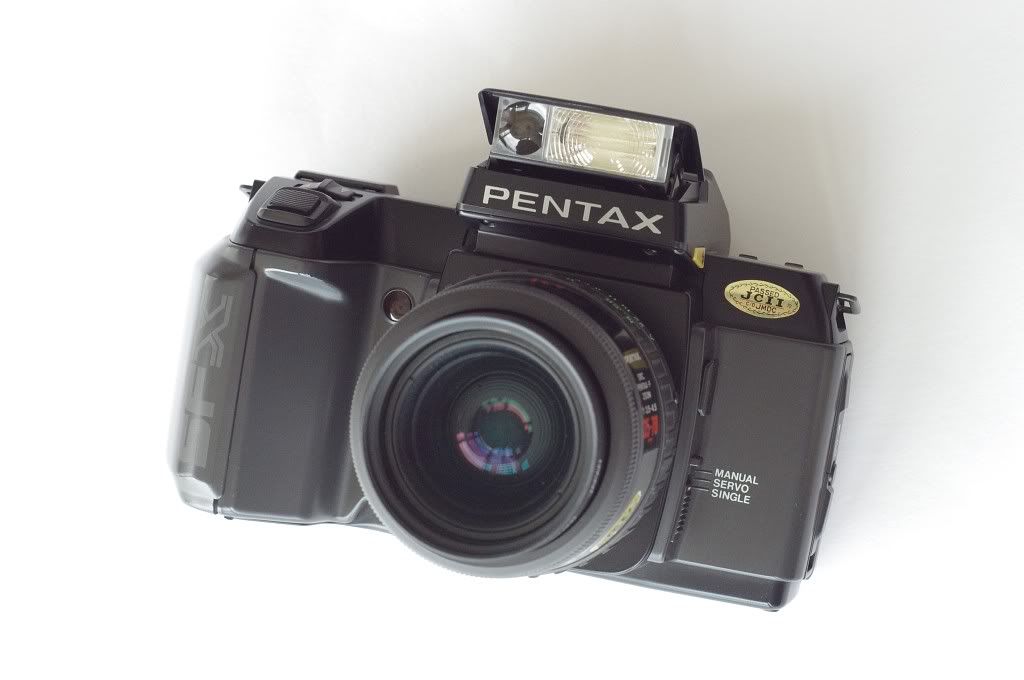
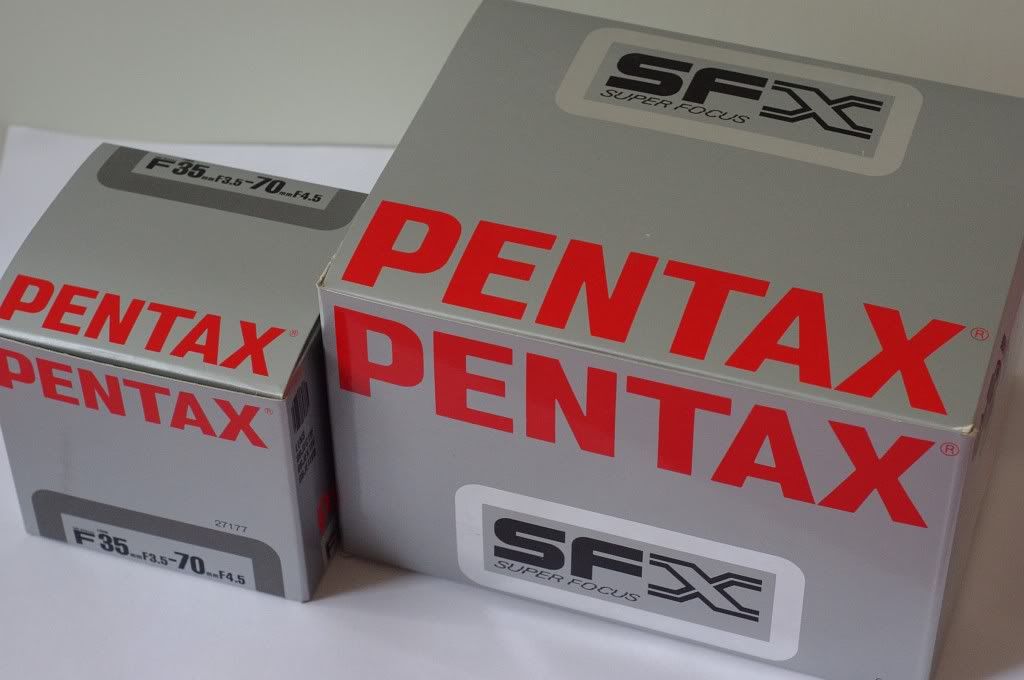
(Above: Do the boxes and packages just look like new? Well, you should see how I treasure my Pentax items! :-p)
This is a noisy camera, bulky, awfully looking, large and heavy and slow. The AF is noisy but not so noisy as its film advance, which only advances in a slow speed of 1.8 fps on paper, i.e., without film loaded! Actual film advance speed is actually even slower, at about 1.4 fps only, as I had counted it! Yes, I did do measurbation long time ago back to the old days! ;-D
The major part of the body is made of fibre-glass "plastic" material, though, which is actually really sturdy. Pentax later used "UV hardened" plastic in the Z-1 and Z-1p, which actually could not match with that of the SFX, as those are just true and pure plastics! :-(
The SFX incorporates the original SAFOX (I) AF module and system which I found to be quite sensitive but yet rather sluggish even by the standards of its days. Hunting and re-hunting is its normal behaviour, even outdoor where it hunts less but still usually does so. The AF motor turns the "standard" (nowadays known as "kit") lens (which was a F35-70/3.5-4.5) really fast, but then this has nothing to do with the time required to complete the AF!
In fact, I was cheated by the Pentax marketing for one thing (Yes, there *was* Pentax marketing! ;-)) that the AF system could complete the focusing automatically in 0.3s which is actually just only the travelling time of its AF motor with the kit lens from infinity to closest, with brand new Lithium battery!
In comparison to the K-x, the SFX is actually not only the Ancestor but also the King of Vibration for Mirror Slap! I could hardly handheld to take a blurless photo viewed at 8R at some Tvs just lower than 1/60th second, when I was still young. Hardly believable? :-o So, the green LED indicator at the right-side of the finder is actually correct, i.e., green for 1/60th sec and yellow for 1/30th, as "hand"-shake warning!
So, you may ask me why I bought it then? :-) There are a number of good reasons at that time, when I just built a new AFSLR system from scratch.. The Pentax optics, the SMC, the features and its sold price. In fact, the SFX was just a clone of both the Minolta 7000 and the Nikon F-501, which was the most popular AFSLRs before it. The EOS 620/650 actually came at about the same time as the SFX, in 1987 but the SFX was sold at a marginally lower price than those two older but popular models of M and N. The EOS bodies are a bit more expensive but the most expensive stuff are those "ground breaking" and newly designed EOS lenses.
One of the most important and unique feature of the SFX was the world's first RTF that it had, which is also equipped with a near-IR red-light AF assist spotbeam with projected vertical pattern. Putting aside its uniqueness, the RTF is actually practically very useful and convenient for daily causal shooting. The G.N. of it is 14m at ISO 100, which is yet very powerful by today's standard (as today's built-in flash has become weaker and weaker - the bundled flash of my NEX is only at G.N. 7!). The program curves and options of the SFX is most versatile at its time, better than all the competitors' bodies from C, M and N. It has five program curves, amongst which the user is able to select three whilst the camera will select one of the three curves automatically according to the lens' focal length for the "Normal" program.
But indeed, Pentax's contemporary SLR market failure was starting from the P30/50 (in around 1985) and then the SF models, which Pentax always missed the boats and lacked better insights. By that time, Pentax was still powerful enough to make more better bodies with features that they could easily incorporate, but they didn't. The SFX lacks evaluative and spot/partial metering, which Canon, Nikon and Minolta were all working on these and marketed new products that had all those features not later than 1989. Even the Ricoh XR-X, which was marketed in 1987, was just a perfect SLR. It had the options of Multi-pattern/CWA/Spot metering options and has an innovative 3 fps "gears-less" film advance system. But unfortunately it lacks AF, which Ricoh just was not "powerful" enough to make one, unlike Pentax did.
Anyway, the SFX did not let me down for almost ten years that it served me afterwards, until it broke. The photo output quality of the F and FA lenses was really good and consistent and the body itself is a reliable workhorse, regardless of all the shortcomings and limitations that I have mentioned above. Pentax F series lenses are actually the best AF lenses made by Pentax ever with the best made SMC (which the FA lenses' "SMC" coatings are actually thinner). Furthermore, the old plain vanilla Pentax TTL Auto Off-The-Film flash control system is also very accurate and reliable. It is very predictable afterall although it has no intelligence of any.
The SF line consists only of two models, the SFX and SF7. Both of which were not successful marketing-wise but still kept Pentax in the game. Pentax reacted later with a new lineup, the first models were the Z-10 and Z-1, in 1991.
But yet once again, Pentax had wasted their time and missed once again more market opportunities with their new Z and FA lens line. Pentax's focus point on the Z and the new FA lenses was Power Zoom and Auto Zoom, which was actually plain stupid. They put a lot of efforts in development in-lens motor for power zoom, and with a new lens mount introduced, that is, the KAF2, of which now is crippled to drive the latest SDM lenses!
Practically, the Auto and Power Zoom functions had least practical meaning to SLR shooters. I think Pentax' decision makers at that time had huge mis-belief in power zoom, which they had achieved big success with their Zoom 70 line of P&S compacts.
The sad thing is that the FA line of lenses had been built up to be very complete in the whole 90s. But they did lack even one proper body for the whole 90s as well. People did consider bodies first before lenses at that time as I observed. So, despite the FA line and lenses are actually very good, few people joined Pentax.
Pentax only knew to introduce new models which are 90% or even 99% identical with a different name. Just say the Z-1 and Z-1p have little differences after 3 years (where "p" stands for Panorama). They had a Z-5 and Z-5p at their Japanese home market before the Z-1p which is almost the same as the Z-1p. The Z-20/50/70 are more or less the same bodies with different included/omitted features. Ditto for the later MZ-5/5n/3 more or less are the same body which is small and elegant but nothing powerful and updated and so on..
Many Pentaxians and those early Internet posters including me in the Usenet Newsgroups, back to 1994, asked that Pentax should make at least a crossed sensor and should incorporate more than one AF sensor in the Z-1 update. But unfortunately, Pentax was still unable to include anything new in the Z-1p, after three years of time since the Z-1, which was yet a big disappointment. In fact, the first AFSLR that had a central crossed AF sensor was the film *ist, which was launched as late as in 2003, and was the only model in the "lineup" as the film camera market was just dead shortly!
2. Pentax (IQ)Zoom 90 WR - The World's First Weather Resist Zoom Compact
Which is also the Pentax' First *Camera* (i.e., body + lens!) to be WR, of which this term was first created and used (The LX wasn't as there was no WR lens of any made in 1980!):
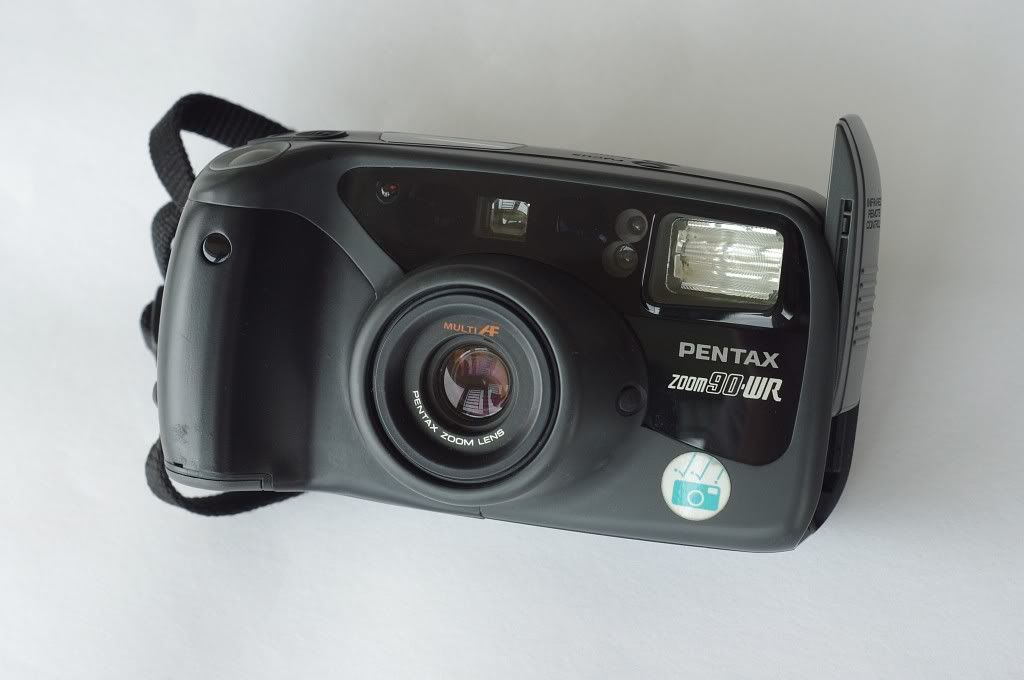
It is not really "compact" when it is compared to its predecessors Zoom 70 something. Indeed, it is by no means considered small even when it is compared to my SFX with the compact standard zoom side-by-side:-
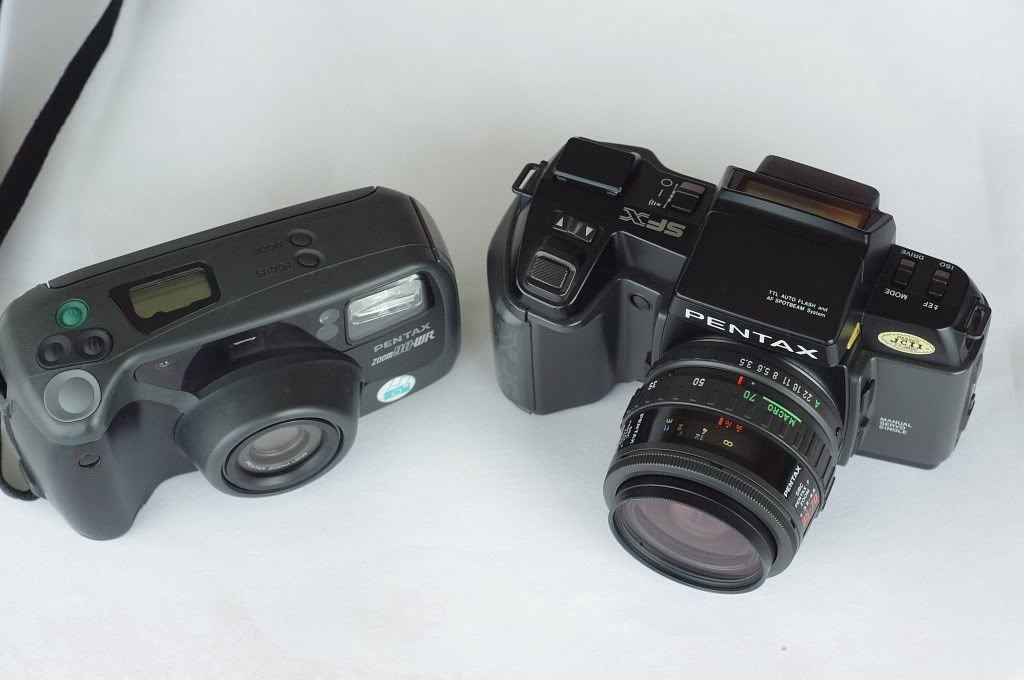
The Zoom 90 marked the glorious days of Pentax in the early 90s for being the market leader of P&S compacts, in particular people wished to buy zoom compacts instead of prime ones for the trend. In 1987, the original Zoom 70 opened up a new era for those zoom compacts and the market share of Pentax grew rapidly. In almost the whole 90s, Pentax' market share worldwide for P&S is in thirty percentage+ per years and could approach 40% sometiems accordingly to JCII (Japanese Camera Industry Institution) figures (the former body of JCIA (Japanese Camera Industry Association) and CIPA (Camera & Imaging Products Association). That is, their gained market was just more than the total sum of that of Canon, Nikon or even plus Minolta for the P&S camera segment! But anyway, those were the days. :-(
Pentax then used the huge money that they earned in the P&S line to re-invest in their AFSLR and lens line, namely Z, MZ and FA series. That explains why the FA Pentax lens lineup is actually the most complete AF lens lineup in the Pentaxland. But with the lack of vision, foresight and better commitment to bodies (but only lenses) by the Pentax management at that time for SLR business, it was reported that their lines were actually suffering loss from year to year and continuous subsides from the cash cow by the adjacent P&S camera division were the "norm" for these years. But indeed this obviously was NOT the right way of doing and running *any* business!
But the rich days of Pentax were gone rather quickly, which already after a long time for more than a decade actually! In the early 2000s, when the camera industry rapidly shifted to digitals and with the rise of DCs as being more popular, Pentax suddenly lost almost all the financial source, income and support for being run by itself standalone. With all the financial troubles and the shrink of market share of P&S cameras down to only 3 to 1% in the first half decade of the Millennium up to 2005 (Wow, just compared to the nearly 40% back to Pentax's most glorious days in the mid-90s), Pentax was finally sold to Hoya as a whole package, including the medical endoscope division which was still profitable, in 2007.
3. Pentax Optio 330 - The first DC in the New Optio Lineup/Family of Pentax:
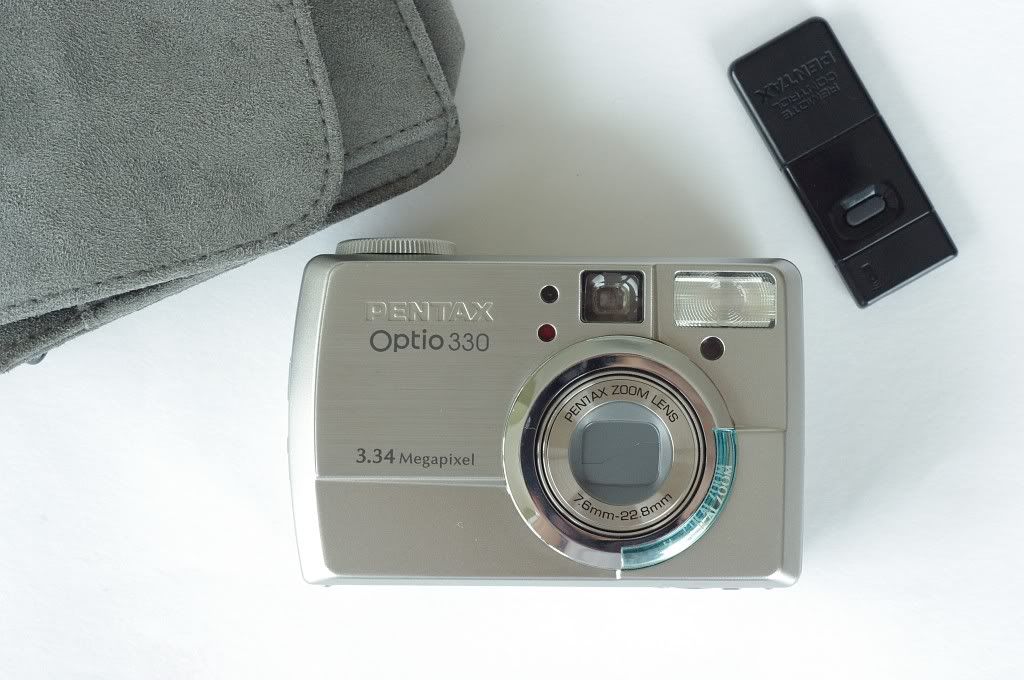
(Above: The softcase is a genuine leather one made by Casio for the sister model variant, when the days Casio and Pentax had their "co-development" and co-operation.)
With the marketing failure of the EI-2000 and EI-200 digial cameras, which were the first DCs made by Pentax, Pentax had tried hard to re-think about what the market trend was and what actually the market needed and struggled to survive - but which was already too late IMHO. The Optio 330, which was the first member of a new line of DCs from Pentax, named with a new family name of "Optio", was launched in 2001. The 330 was intended to be built small and elegant and with quality photos, too (by the standards of its time). I actually saw it was on show in the Japanese Photo Expo 2001 at Odaiba, Tokyo which was held in March 2001. I bought this camera subsequently.
Well, all of my above cameras were retired and of I did not use them anymore years ago. In fact, my Optio 330 is not working anymore as both of the original proprietary Li-ion batteries had expired earlier and now they are just blown up like balloon and are rather difficult to be inserted into the battery compartment (tsim tongs is required to extract them if I had to do so)! :-( Yes, Li-ion will expire even if they are not charged/discharged as they have a limited shelf time and their lives are not based on the number of recharging cycles and times, unlike NiMHs and NiCds.
To me, all of my cameras introduced in my this post are just complete obsolete things to me as photographic gear. They now have no practical shooting meaning of any and for long actually. They are just collection items of mine but they do share my many precious moments with me and they completed their tasks not only for photo memories, but all many memories of mine in my life. I think I shall keep them "forever", until I die. :-)
Read Also:-
As Time Goes By.. (II)
My First Camera
Cameras, Photos and Memories - As Time Goes By..
Disruptive Innovation and Pentax